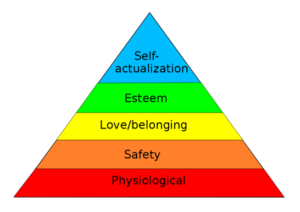After our in-class discussion and analysis on consumer wisdom, my perspective on the topic has definitely changed since my first blog post. Here are some of my biggest takeaways:
Throughout our last class, I saw a significant correlation between Maslow’s Hierarchy of needs and the different dimensions of consumer wisdom. Maslow’s Hierarchy of needs stacks up as follows:

The five buckets of consumer wisdom: Intentionality, Contemplation, Emotional Mastery, Openness, and Transcendence, do not match up exactly with the hierarchy, but I definitely see some parallels. When considering potential purchases, it only makes sense that one would consider certain products or services that meet your individual needs and wants. The bottom of Maslow’s pyramid represents needs in your life, and as those are satisfied, one can move onto wants. This mindset spills over into modern-day consumerism. Once your needs are met, such as food, water, living, and healthcare, a consumer has the flexibility to address the wants in their life. The wiser the consumer, the better these wants are satisfied.
Looking at the actual categories, I’ve identified a few particularly strong equivalents. The first connection between the two models is self-actualization and transcendence. In the consumer survey we received, the questions about transcendence were all about thinking beyond yourself and being able to think more abstractly about the impact of a purchase. Transcendence captures the big picture, such as the broader impact of consumerism on the environment and economy. Self-actualization refers to one’s ability to understand his or her position in life to its fullest, which allows you to position yourself in the best way possible. In consumerism, if you fully understand a product, such as what went into making the it and how it plays out in a broader economy, you can make a more educated decision on whether or not to make a purchase. Both self-actualization and transcendence requires a person to remove his or herself from the moment, take a step back, and think more critically about a scenario. This is definitely the most complex or wise level to both models, which I think helps explain why a lot of our classmates noted that transcendence was the category they needed the most work on.
Another interesting connection between the two models is in regards to emotional mastery and both the esteem and love/belonging levels. In Maslow’s theory, esteem recognizes that people need to feel a certain level of importance about oneself and that other people share the same sentiment. Furthermore, the love/belonging tier reflects peoples’ ambition to feel wanted by the important people in their lives. In the consumer wisdom model, emotional mastery reflects when someone has a strong ability to buy products/services that enhance your positive emotions, while mitigating negative emotions. When you are able to do so, I certainly believe you are enhancing one’s esteem and relative level of comfortability in life. For example, let’s say you really enjoy fishing. As a result, you decide to invest in a state-of-the-art fishing rod, which has helped with your ability to fish over time. This fishing rod has helped invoke positive emotions, which in return has boosted your self-esteem. Having more confidence in yourself, when channeled healthily, can help increase your sense of belonging in life. These concepts are all interconnected and can be key to understanding the drivers in consumer behavior.